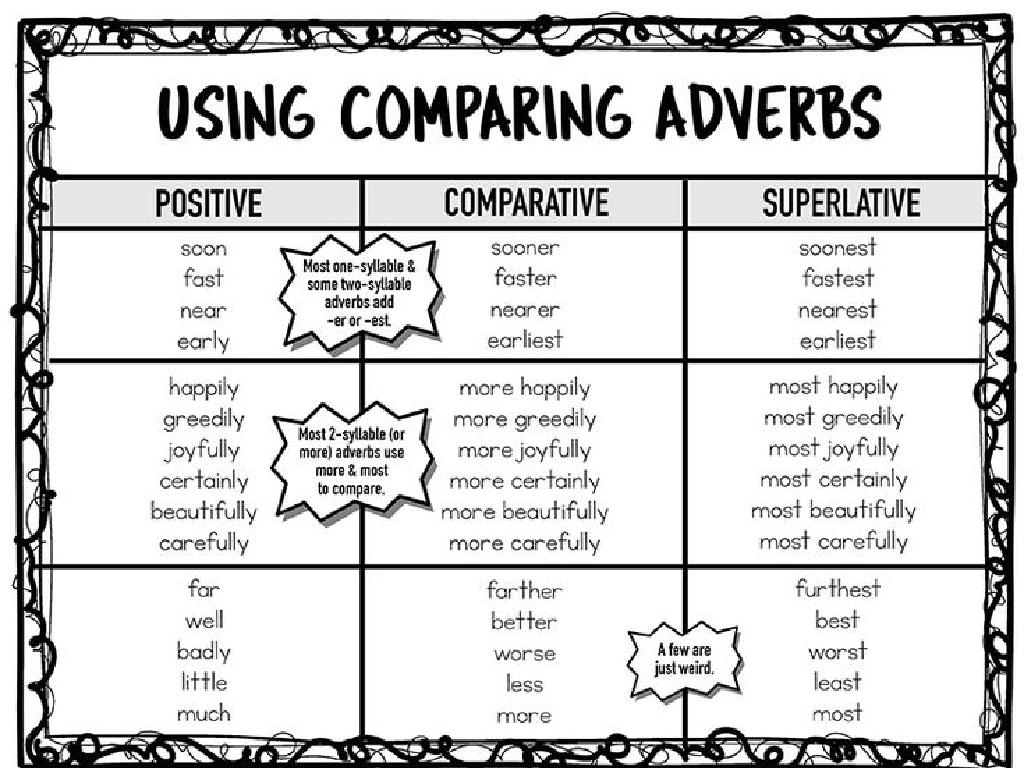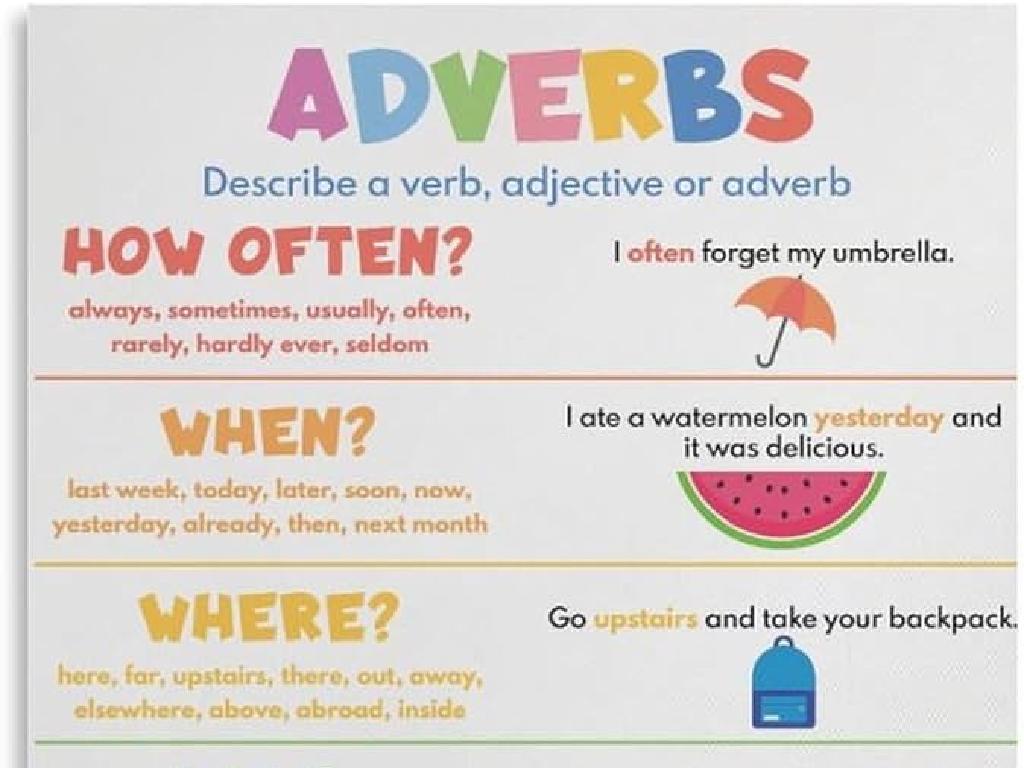Describe, Classify, And Compare Kingdoms
Subject: Science
Grade: Fourth grade
Topic: Classification
Please LOG IN to download the presentation. Access is available to registered users only.
View More Content
Exploring the Kingdoms of Life
– What is Classification?
– Sorting living things into groups based on features
– Purpose of Classifying
– Helps us understand how living things are related
– Overview of Five Kingdoms
– Monera, Protista, Fungi, Plantae, Animalia
– Characteristics of Kingdoms
– Each kingdom has unique traits, like cell type and structure
|
This slide introduces the concept of classification in biology, which is the process of sorting living things into groups based on their characteristics. Explain that classification helps scientists and students understand the relationships and differences between organisms. Briefly introduce the five kingdoms: Monera (single-celled organisms without a nucleus), Protista (mostly single-celled, complex cells), Fungi (organisms that decompose and absorb nutrients), Plantae (plants that use photosynthesis), and Animalia (animals that consume food). Highlight that each kingdom has unique features that distinguish it from the others, such as cell type, structure, and method of obtaining nutrients. Encourage students to think about the diversity of life and how these groups help us make sense of the natural world.
Exploring Biological Classification
– What is classification?
– It’s like sorting things into groups based on what they have in common.
– Reasons for classifying organisms
– It makes it easier for scientists to study and talk about living things.
– Cells: The building blocks of life
– All living things are made up of cells, the smallest unit of life.
– Comparing different kingdoms
– Organisms are grouped into kingdoms like plants and animals based on big differences.
|
This slide introduces the concept of classification in biology, which is the process of organizing living things based on their similarities. Emphasize the importance of classification in helping scientists communicate and understand the vast diversity of life. Discuss cells as the basic unit of life and how all living organisms are composed of them. Encourage students to think about the characteristics that might be used to compare different kingdoms, such as how they obtain food, their cell structure, and how they reproduce. This will set the foundation for understanding the broader topic of biological classification and the various kingdoms of life.
Exploring Kingdom Monera
– Monera: Single-celled, no nucleus
– Tiny organisms, simpler than other life forms.
– Bacteria: Abundant Monerans
– Bacteria are everywhere, even inside us!
– Monera’s roles in our lives
– They help make yogurt and decompose waste.
– Monera in nutrient recycling
– They break down dead matter, returning nutrients to the earth.
|
This slide introduces students to Kingdom Monera, emphasizing its unique characteristics such as being single-celled and lacking a nucleus. Highlight the omnipresence of bacteria, a type of Moneran, and discuss their beneficial roles, such as aiding in food production (like yogurt) and in the decomposition process. Explain how Monera are essential in the nutrient cycle, breaking down dead organisms to release nutrients back into the environment. Use simple language and relatable examples to help students understand these concepts. Encourage them to think of other ways Monera might affect their daily lives.
Exploring Kingdom Protista
– Protista: Diverse Life Forms
– A kingdom of miscellaneous organisms that don’t fit in other kingdoms.
– Single-celled or simple multicellular
– Organisms like algae and amoebas, some make their own food while others hunt.
– Algae’s role in ecosystems
– Algae produce oxygen and are crucial for aquatic food chains.
– Protozoa: Tiny Hunters
– Protozoa are like tiny animals, eating bacteria and other microorganisms.
|
Kingdom Protista is known as the ‘odds and ends’ kingdom due to its variety of organisms that don’t quite fit into the other kingdoms. This slide introduces students to the diversity of Protista, including both single-celled and simple multicellular organisms. Emphasize algae’s vital role in producing oxygen and forming the base of aquatic food chains, supporting life in water environments. Discuss protozoa, which are similar to tiny animals, and explain how they hunt for food like bacteria. Encourage students to think about the importance of these tiny organisms in larger ecosystems.
Exploring Kingdom Fungi
– Fungi: Not just mushrooms
– Fungi include molds, yeast, and mushrooms.
– Fungi as decomposers
– They help recycle nutrients by breaking down dead things.
– Fungi vs. Plants
– Unlike plants, fungi don’t make their own food with sunlight.
– Importance of fungi in nature
|
This slide introduces students to the Kingdom Fungi, emphasizing that it includes a variety of organisms, not just mushrooms. Highlight the role of fungi as decomposers in ecosystems, breaking down dead organic matter and returning nutrients to the soil. Discuss the differences between fungi and plants, such as fungi’s inability to photosynthesize. Explain the importance of fungi in natural processes and their ecological value. Encourage students to think of examples of fungi they have seen and to consider how these organisms contribute to the environment.
Exploring Kingdom Plantae: The Green Kingdom
– Plantae: Earth’s green wonders
– Kingdom Plantae includes all different types of plants.
– Photosynthesis: Plants’ food factory
– Using sunlight, water, and CO2, plants make their own food.
– Plantae diversity: Mosses to redwoods
– Plants vary from small mosses to huge redwood trees.
– Comparing plant sizes and habitats
– Observe how plants differ in size and where they grow.
|
This slide introduces students to the Kingdom Plantae, emphasizing the unique characteristic of photosynthesis that allows plants to produce their own food. Highlight the vast diversity within the plant kingdom, ranging from the smallest mosses to the largest redwood trees. Encourage students to think about the different sizes of plants they have seen and the variety of places where plants can live. Use this opportunity to discuss how plants adapt to their environments and the importance of plants in our ecosystem. This will set the stage for further exploration of plant classification and the role of plants in the food chain.
Kingdom Animalia: The Kingdom of Animals
– Animalia: A world of diversity
– Kingdom Animalia includes all animals
– Characteristics: Multicellular, mobile
– Animals are made of many cells and can move
– Exploring Diversity: Sponges to humans
– Range from simple sponges to complex humans
– Comparing Animals: Size, habitat, diet
– Animals differ in size, where they live, and what they eat
|
This slide introduces students to the Kingdom Animalia, one of the main classifications of life. Emphasize that this kingdom includes all animals, from the simplest sea sponges to complex organisms like humans. Highlight that animals are multicellular, meaning they are made up of many cells, and they have the unique ability to move on their own at some point in their life cycle. Discuss the vast diversity within the animal kingdom, and encourage students to think about the different sizes, habitats, and diets of animals they know. This will help them understand the broad range of life forms that exist within this single kingdom.
Comparing Kingdoms: Similarities & Differences
– Kingdoms: Alike and different
– All kingdoms have living organisms, but they differ in many ways.
– Cell structure in kingdoms
– Some have single cells (like bacteria), others have complex, multi-cellular structures (like animals and plants).
– Nutrition across kingdoms
– Organisms get energy differently; some make their own food (plants), while others consume (animals) or decompose matter (fungi).
– Complexity levels in kingdoms
– From simple bacteria to complex animals, each kingdom has varying levels of complexity.
|
This slide aims to help students understand the concept of biological classification by comparing the characteristics of different kingdoms. Discuss the basic similarities that all living organisms share, such as the ability to grow and reproduce. Then, delve into the differences in cell structure, explaining that some organisms are made up of a single cell, while others have many cells with specialized functions. Nutrition is another point of comparison; some organisms produce their own food through photosynthesis, while others must eat or absorb nutrients. Lastly, address the complexity of organisms within each kingdom, from simple single-celled bacteria to complex multi-cellular animals. Use the comparison between a mushroom (Fungi) and a rose (Plantae) to illustrate these points with familiar examples. Encourage students to think of other examples within each kingdom.
Class Activity: Kingdom Classification
– Create Kingdom Cards
– Draw one organism per kingdom
– Think of animals, plants, fungi, etc.
– Label your organisms
– Write the name and kingdom on each card
– Classify and explain your choices
– Share why you placed each organism in its kingdom
|
This activity is designed to help students apply their knowledge of the five kingdoms of life by creating visual aids. Provide students with cardstock or paper to draw and label an organism from each of the kingdoms: Animalia, Plantae, Fungi, Protista, and Monera. Encourage creativity in their drawings and ensure they label each card with the organism’s name and kingdom. After creating the cards, students will present their cards to the class, explaining why they classified each organism into its respective kingdom. This will reinforce their understanding of the characteristics that define each kingdom. Possible variations of the activity could include working in groups, creating a kingdom poster, or even a digital slideshow if resources allow.
Conclusion: The Five Kingdoms of Life
– Recap the Five Kingdoms
– Monera, Protista, Fungi, Plantae, Animalia with unique traits
– Significance of classification
– Organizing living things helps us understand and study them better
– Reflect on today’s discoveries
– Think about one interesting fact you learned
– Engage with Q&A session
|
This slide aims to consolidate the students’ understanding of the five kingdoms of life and emphasize the importance of classification in biology. Begin by recapping the characteristics of each kingdom: Monera (single-celled, no nucleus), Protista (diverse, mostly single-celled), Fungi (absorb nutrients), Plantae (photosynthetic), and Animalia (multicellular, consume food). Highlight how classification helps scientists communicate and make sense of the vast diversity of life. Encourage students to think about what they found most fascinating during the lesson and to share their thoughts. Conclude with a Q&A session to address any uncertainties and reinforce their knowledge.





